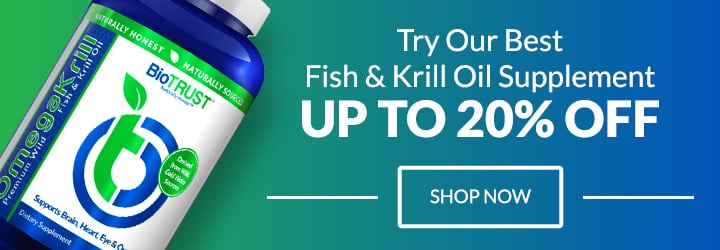Anti-Inflammatory Diet: How to Fight Inflammation with Food

Inflammation is a completely normal biological process. It’s a vital component of the body’s immune response. Ideally and even typically, inflammation is a self-limiting process, such as when we’re fighting infection or recovering from a wound. In other words, the body initiates an inflammatory response when it’s trying to defend against pathogens or facilitate the healing process—both of which are intended to be relatively short-lived.
However, problems arise when there are persistent, moderately elevated levels of inflammation, resulting from excessive and inappropriate activity of the immune system. This is often referred to as chronic low-grade inflammation, which can result from a variety of “environmental insults.”1
And this, my friend, is what has earned the term “inflammation” such a negative connotation in everyday speak. You see, this type of inflammation is associated with a laundry list of issues and complications, such as metabolic disturbances. In fact, many in the scientific community believe this chronic low-grade “metaflammation” is at the heart of most—if not all—non-infectious lifestyle-driven health complications.2
And as you might have guessed, diet is one of the most profound environmental insults. In other words, dietary factors can have a profound effect on inflammation. Some have even described dietary offenders as “false inflammatory triggers.”3
But here’s the catch: The food you eat (or don’t eat) can impact your inflammatory balance both through pro-inflammatory and anti-inflammatory mechanisms. In plain speak, that means there are anti-inflammatory foods and nutrients, and those will serve as the foundation of an anti-inflammatory diet, which is also designed to limit (or eliminate) those foods and nutrients that have an inflammatory effect.
What is an anti-inflammatory diet?
An anti-inflammatory diet is one that:
- Emphasizes anti-inflammatory foods (which contain nutrients with anti-inflammatory properties)
- Minimizes pro-inflammatory foods and nutrients
- Addresses lifestyle factors that influence inflammation
- Minimizes “environmental insults” that promote unhealthy levels of inflammation
The Top Anti-Inflammatory Foods
As alluded to above, there are several dietary components associated with lower inflammation, and these give us keen insight into so-called anti-inflammatory foods:1,4,5
- Natural antioxidants
- Fruits and vegetables
- Whole grains
- Herbs and spices
- Omega-3 fats
- Fiber
- Moderate alcohol intake
- Vitamin C
- Vitamin D
- Vitamin E
- Vitamin K
- β-carotene
- Magnesium
More Anti-Inflammatory Diet Tips
• Eat plenty of fiber. We’ve talked quite a bit about the benefits of dietary fiber, and now you can add to the growing list that higher fiber intakes are associated with lower levels of inflammation.6 On one hand, high-fiber anti-inflammatory foods can help support a healthy balance of gut bacteria, which seems to play an integral role in supporting a healthy inflammatory balance.3,7 On the other hand, foods high in fiber also tend to package several other key anti-inflammatory compounds, such as vitamins, minerals, and antioxidants. So, before you go out and buy some sawdust powder to ramp up your fiber intake (most people barely consume half of the recommended 30 – 40 grams per day), focus on eating more fiber-rich anti-inflammatory foods, like fruits, vegetables, whole grains, legumes, nuts, and seeds.
• Load up on veggies and fruits. As mentioned above, fruits and veggies are densely packaged with fiber, but there’s more to the story. For starters, they’re loaded with phytonutrients—that is, antioxidants that play a critical role in supporting a healthy oxidative balance, which in turn supports a healthy inflammatory balance.
For example, anthocyanins are the anti-inflammatory phytonutrients that give fruits (such as berries) and vegetables their red, purple, and blue colors. Shoot for 4 – 5 half-cup servings each of a variety of colorful fruits and veggies, which are also great sources of the key micronutrients associated with lower levels of inflammation:
- β-carotene: Carrots, pumpkin, sweet potatoes, mangos, papaya, cantaloupe, dark leafy greens, bok choy, bell peppers, and broccoli
- Vitamin C: Oranges, grapefruit, clementine, tangerines, bell peppers, bok choy, broccoli, Brussels sprouts, strawberries, pineapple, kiwifruit, cauliflower, dark leafy greens, cabbage, and tomatoes
- Vitamin E: Dark leafy greens (such as spinach, kale, mustard greens, collard greens, turnip greens, and Swiss chard), asparagus, broccoli, bell peppers, and tomatoes
Special Offer:Get MetaboGreens up to 20% OFF (very limited inventory)
• Eat fatty fish and seafood 3 times per week. There’s good reason health organizations like the American Heart Association urge folks to eat fatty fish—which are certainly noteworthy among anti-inflammatory foods—at least twice a week. They’re the best dietary sources of the key omega-3 fats DHA and EPA. Research shows that consuming roughly three 3 ½-ounce servings of fish each week is associated with significantly lower levels of inflammatory markers.9 When it comes to choosing fish and seafood, not all choices are equal. We want to emphasize options that are rich in the omega-3 fats DHA and EPA. We also have to take into consideration factors like sustainability and heavy metals (e.g., mercury). Generally speaking, the best fish and seafood (which also tend to be the best dietary sources of vitamin D) that meet these criteria include:
• Focus on healthy fats. In addition to the omega-3 fats found in fatty fish, thanks to their “healthy fats,” we can also add to our list of anti-inflammatory foods avocados, olives, and extra virgin olive oil, the hallmark of the Mediterranean diet, which is arguably the best example of an anti-inflammatory diet. The anti-inflammatory properties of these foods can be traced back to both their fat content (i.e., monounsaturated fats) as well as their antioxidants. Nuts and seeds also contain anti-inflammatory fats, fiber, and key micronutrients, including magnesium. Meanwhile, you’ll want to limit your intake of industrially-produced vegetable and seed oils (e.g., soybean, corn, canola, safflower, sunflower, and cottonseed oils), which are rife with omega-6 fats and other inflammation-promoting compounds.
• Go the extra mile for pasture-raised, organic meat, dairy, and eggs. As we’ve talked about before, one of the greatest advantages meat, dairy, and eggs from pasture-raised animals is their fatty acid profile (more omega-3 fats, a better omega-6 to omega-3 ratio, and more conjugated linoleic acid), making them strong candidates as anti-inflammatory foods. What you’re not getting when you go the extra mile matters too. Your investment means no GMO, no antibiotics, no added hormones, and no persistent pesticides, which could potentially have inflammatory properties.
• Watch what you drink. In case there’s any question, sugar-sweetened beverages—including sodas and juice—don’t qualify as anti-inflammatory foods. Quite the opposite, in fact, as excessive sugar intake is one of the prime false inflammatory triggers. On the other hand, coffee, green and black tea, and red wine are all associated with lower levels of inflammation, and they are likely to have direct anti-inflammatory properties thanks to their phytonutrients (such as catechins in tea and resveratrol in grapes). While moderate alcohol consumption (e.g., a 5-ounce glass of wine) may be a good thing, keep in mind that excessive alcohol has the opposite effect.
• Careful with the carbs. No, you don’t need to go ultra-low-carb, although there’s some evidence to suggest that a properly-formulated, whole-food-based ketogenic diet may improve inflammatory balance.13 What is abundantly clear, however, is that an anti-inflammatory diet encourages the consumption of whole plant-based foods, such as fruits, vegetables, tubers, nuts, seeds, whole grains, and legumes, which have a low glycemic load, promote glycemic control, and are packaged with nutrients (e.g., antioxidants, fiber, vitamins, and minerals) that support healthy levels of inflammation. On the other hand, here are some things you won’t find in anti-inflammatory foods: refined grains/starches and added sugar.
• Be liberal with herbs and spices. Nearly all herbs and spices are nicely packaged with phytonutrients (e.g., flavonoids) that have powerful antioxidant properties and promote a healthy balance of inflammation. Cocoa, garlic, ginger, oregano, pepper, rosemary, thyme, and turmeric are some of the most noteworthy.5
What Foods Cause Inflammation?
As mentioned above, an anti-inflammatory diet has as much to do with what you don’t put into your mouth as what you do. And while we’ve previously talked about some of the major dietary factors that serve as pro-inflammatory triggers, it bears repetition. The following dietary factors promote inflammation:
- High intake of refined starches/grains
- High intake of sugar
- A higher glycemic load
- High intake of saturated fat
- Any intake of industrially-produced trans fats
- Excessive intake of omega-6 fats
- Low intake of omega-3 fats
- Low intake of natural antioxidants
- Low intake of fiber
- Low intake of magnesium
- Low intake of fruits and vegetables
In other words, an anti-inflammatory diet is the antithesis of the typical Western-style diet, which is appropriately referred to as a “fast food” diet due to its reliance on heavily processed, ultra-refined, pre-packaged convenience foods.
Other Inflammation Triggers
There’s no single anti-inflammatory diet. Arguably, the best examples are Mediterranean, plant-based (e.g., macrobiotic), and Paleolithic diets, but it’s important to note that these are components of an overall lifestyle.1,14 In other words, while they’re abundant in anti-inflammatory foods, they also address several other key areas, which are essentially “danger signals” that serve as continuous false inflammatory triggers, including:3
- Insufficient physical activity
- Lack of sunlight (low vitamin D status)
- Inadequate sleep
- Chronic stress
- Environmental pollution
Anti-Inflammatory Diet: A Follow Up
- An anti-inflammatory diet means eating more anti-inflammatory foods and fewer inflammation-promoting foods.
- In general, anti-inflammatory foods are nutrient-dense foods, herbs, and spices that are packaged with naturally-occurring antioxidants, vitamins, minerals, fiber, and healthy fats.
- An anti-inflammatory diet involves more than just eating more anti-inflammatory foods. It’s a lifestyle-based approach that also addresses environmental insults and minimizes false inflammatory triggers.







